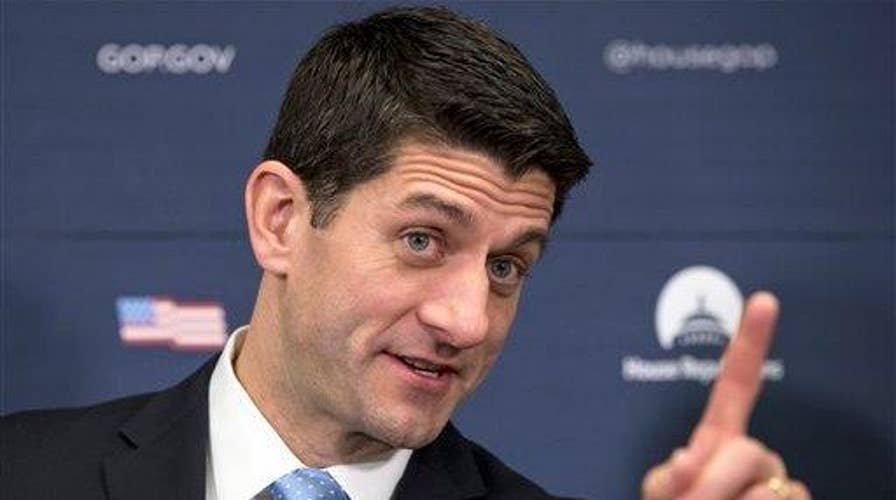“Time is the longest distance between two places” -- Tennessee Williams
Capitol Hill may be the only place where something that is supposed to take 15 minutes usually consumes 28 minutes, then triggers un-muted braying when the event suddenly consumes just 19 minutes.
Such was the case Wednesday in the House as lawmakers voted on a bill to sanction Iran.
Rep. Bradley Byrne presided over the vote. When the roll call began at precisely 11:30 am et, the Alabama Republican stared over the House chamber from the dais and issued a stern warning to his colleagues.
“This IS … a 15 minute … vote,” exhorted Byrne. He punctuated his words for emphasis like a high school vice principal, running Saturday morning detention.
Byrne then rapped the gavel, launching the vote sequence.
“15:00” immediately flashed on electronic clocks mounted in the House chamber. Seconds dripped off the clocks as lawmakers trickled into the chamber.
A few weeks ago, House Speaker Paul Ryan, R-Wis., stood where Byrne held forth on the rostrum. The speaker reminded lawmakers about the importance of timeliness.
“Members should attempt to come to the floor within the 15-minute period as prescribed by the first ring of the bells,” Ryan said. “As a point of courtesy to each of your colleagues, voting within the allotted time would help with the maintenance of the institution.”
The House generally allocates 15 minutes for the first vote in a series, giving lawmakers ample time to come to the floor. But those votes inevitably creep toward a half hour as laggards dawdle over to the Capitol from the House office buildings.
The frantic calls of “One more! One more!” echo through the corridors as lawmakers dash up staircases, wildly waiving voting cards in the air as though holding the winning Powerball ticket.
The problem is that it’s usually not just “one more” out-of-breath lawmaker racing to make the vote. Or two more. Or three more.
Try about 50.
Or in the case of Wednesday, 137 more.
When the digital clock dissolved to “00:00,” Byrne hit the gavel as though to close the vote.
The din inside the House chamber rose as members poured through the doorways and scrambled to stuff their voting cards into the voting machines. A cadre of Republicans in the rear of the chamber applauded and tried to goad Byrne to halt the vote.
“Have all members voted?” asked Byrne two minutes later, triggering more pandemonium on the floor.
Ryan personally implored members to hustle or they were going to miss it.
Byren banged the gavel.
“On this vote, the yeas…” thundered Byrne, signaling that the tally was closed.
Done. Fin.
Bedlam ensued. Californian Democratic Reps. Julia Brownley, Ami Bera and Jackie Speier wandered around the well, dumbfounded. The vote was closed. The group of GOPers in the back, led by the verbally rambunctious Rep. Don Young, R-Ark., roared in approval of Byrne’s temporal discipline.
191 yeas. 106 nays. A staggering 137 absences in the now 434-member House.
“Oh crap!” said Rep. Adam Kinzinger, R-Ill., one of the GOP’s most-outspoken foreign policy voices. “Did I really just miss a vote on Iran?”
Said Rep. Bob Gibbs, R-Ohio: “There are some people who are pretty upset. That was an important vote.”
Florida GOP Rep. Jeff Miller said, “It’s not as if there wasn’t plenty of notice.”
Republicans chairing the House debates have followed Ryan’s orders closely. Last week, Rep. Virginia Foxx. R-N.C., presided.
The backbencher crowd of Don Young, Ohio Reps. Todd Young, and Rep. Pat Tiberi, Ohio, egged her on to close the vote after she rapped the gavel at the 15-minute mark.
The real shot across the bow came on January 8. The House voted on an amendment about class action lawsuits offered by Rep. Steve Cohen, D-Tenn. The House rejected Cohen’s amendment, 211-158. But 64 members failed to make the vote.
The precedent was set. And on Wednesday, Byrne gaveled down the vote on the Iran bill at the 19-minute mark, nearly sparking an insurrection over a roll call scheduled to run just 15 minutes.
Members who missed the vote were incensed, especially as some were still coming through the doors or stuck in the basement waiting on an elevator.
House Minority Leader Nancy Pelosi, D-Calif., applauded Ryan’s effort.
But she questioned the wisdom of stopping the vote when lawmakers were still scrambling for the chamber, particularly on Iran legislation.
“It was a very important vote on Iran and everyone wanted to be on the record,” Pelosi said. “I think the gaveling was premature.”
But perhaps this was precisely the vote on which to make a point.
“If they would have done it on naming a Post Office, people wouldn’t have cared,” said Rep. Cynthia Lummis, R-Wyoming. “This was a blaring wakeup call.”
A few minutes later, House Majority Leader Kevin McCarthy, R-Calif., went to the floor and asked unanimous consent to nullify the Iran vote.
Not surprisingly, nobody objected.
Poof. The vote disappeared into thin air. It was as if it never happened. The House didn’t pass the bill. The House scheduled a revote for January 26.
“Because many members missed this important vote, it was vacated and we’ll revote,” Ryan spokeswoman AshLee Strong said.
++++++++++++++++++
Lawmakers introduced 51 bills to create an automated voting system for the House as far back as 1886. Thomas Edison developed a patent for the first electronic voting system in 1869. He presented his contraption to lawmakers who promptly rejected it. There was concern it would “destroy the only hope the minority have of influencing legislation,” Edison said.
That meant the House burned decades (perhaps literally), verbally calling the names of all 435 House members (twice) during each roll call vote. The process consumed an average of 45 minutes a pop. This chewed up 275 hours or 55 legislative days during one year.
Still, there was resistance to the automated system. Members of the now-defunct “Committee on Accounts” fretted that accelerating the voting process electronically would “flood the country with legislation” and interrupt a tool to “filibuster by means of roll calls.”
In other words, efficiency wasn’t the goal.
In 1973, the House finally instituted an electronic, automated voting.
The House gave each lawmaker an electronic card to be inserted into any voting machine spread around the floor. The lawmakers would press a green button for “aye,” a red button for “nay” and an amber button for “present.”
The names of each member would appear on gigantic tally boards nearby. When a member votes, a “Y,” “N” or “P” appears on the screens next to their name.
Frank Ryan (no relation to the current speaker) was an All-Pro NFL quarterback for the Los Angeles Rams, Cleveland Browns and the Washington Redskins, leading the Browns to their last NFL title in 1964. But Ryan was more than just an athlete.
He’s the only man to ever have a doctorate in mathematics to play in the NFL. The House hired Ryan to develop automated information services for the House, including the launch of the electronic-voting system.
At the time, Ryan and the House leadership established “15 minutes” as a reasonable swath of time for the first vote in a series.
For decades, word around the Capitol was that Ryan and others settled on the 15 minute timeframe because that’s the length of a quarter in football. When reached Thursday at his home in Grafton, Vermont, Ryan chuckled at that assertion.
“I always thought of life as divided into 15 minute segments,” he said in an interview. “We just figured 15 minutes was enough time to get people to walk to the chamber. That is, if they started at the right time.”
Clock management is an essential quality for quarterbacks like Frank Ryan. But not necessarily for members of Congress. Lawmakers are often yanked in multiple directions at once -- be it a constituent meeting, a speech in downtown Washington, a fundraiser, a daughter’s dance recital -- or a roll call vote.
In 2007, the House probed an issue related to floor votes. The chamber’s GOP leadership often called on then-Rep. Steve LaTourette, R-Ohio, to preside over the House. During one meeting, LaTourette remarked that the “same people are late today who were late 10 years ago.”
That’s just human nature. Some people are just on time. Others are tardy. Even members of Congress.
Some lawmakers remarked that they don’t rely on the clock at all to dictate when it’s time to head to the floor. The clock could sit at 00:00 but that wouldn’t matter.
The key (at least in the past) has been to watch to see how many outstanding votes remain. If the clock reads 00:00 and there are 150 people who haven’t voted, a member knows he or she still has enough time to hoof it to the floor.
Perhaps no longer.
After the vote closed on Wednesday, the House voted on an environmental measure.
Though the House allotted only five minutes to that vote, many lawmakers lingered on the floor. Psychologically, it was still embedded in them how long a vote series should run. So they just hung out on the floor, talking, even though voting was done.
Altering the Circadian Rhythms of lawmakers is quite an enterprise.
This year, House Republicans plan to advance all 12 annual spending bills to fund the government. No jumbo “omnibus” appropriations bills at the end of the year with everything glommed together.
McCarthy says each spending bill consumes almost 12 hours to complete -- on and off the floor.
The House intends to allow an open-ended and time-consuming amendment process. But a seven-week break this summer to accommodate the political conventions exacerbates the challenge to complete the bills.
“We have some compression in the schedule,” said Speaker Ryan. “Votes are going to be all over the place.”
House Majority Whip Steve Scalise, R-La., says there will be “a lot of late-night votes.”
House Republicans pushed for a return to regular order under the new, Paul Ryan regime. Regular order takes many forms. Especially if lawmakers aspire to do big things in short time periods.
And that means no truancy for votes.
If this fails, perhaps Ryan might consider discipline meted out to tardy high school students: detention.





